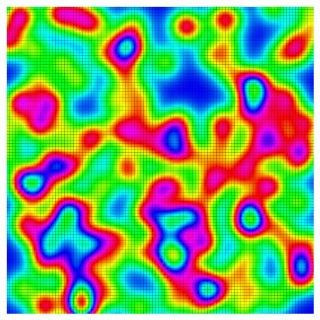Apr 8 2015
Scientists at the Los Alamos National Laboratory, leading an international team of researchers, have shown that the high purity single crystals of superconducting material (CeCoIn5), possessing the highest superconducting temperature for a material based on cerium, could function as a suitable system for analyzing the effect of disorder in crystalline materials.
 Numerical simulation of the magnetic inhomogeneity (red = magnetism, blue = superconductivity) caused by replacing 1% of the indium atoms in a superconductor (CeCoIn5) with cadmium atoms. The field of view is approximately 100 nanometers along each edge. (Cover Image from Seo et al., Nature Physics, 10, February 2014). Image courtesy of N. J. Curro (UC Davis) and Los Alamos National Laboratory
Numerical simulation of the magnetic inhomogeneity (red = magnetism, blue = superconductivity) caused by replacing 1% of the indium atoms in a superconductor (CeCoIn5) with cadmium atoms. The field of view is approximately 100 nanometers along each edge. (Cover Image from Seo et al., Nature Physics, 10, February 2014). Image courtesy of N. J. Curro (UC Davis) and Los Alamos National Laboratory
This discovery is considered to be the Rosetta Stone of high temperature superconductivity. It shows the pathway for quantitatively examining the interplay that takes place between superconductivity, disorder and magnetism in high temperature superconductors. This investigation is made possible by substituting specific atoms with dopants in the superconductor.
On the Rosetta Stone, the same message was written in three different scripts, and this gave scholars important insights into ancient languages. The high purity of CeCoIn5 enables investigation of the interplay that takes place between superconductivity, magnetism and disorder in cuprates, pnictides, and heavy fermions, which are unconventional superconductors of three different classes.
Researchers would be able to decode the complex emergent phenomena that takes place in various classes of unconventional superconductors, and may also be able to develop a complete theory for high-temperature superconductivity, using this versatile model system.
Superconductivity allows electricity to flow without allowing any loss of energy to take place. This takes place at an extremely low temperature, and it disappears when the temperature exceeds a critical temperature (Tc). In 1986 unconventional superconductors, a new class of materials, were discovered.
When compared with known conventional superconductors, these new superconductors preserve superconductivity at much higher temperatures. Researchers having been trying to understand more about the mechanisms related to unconventional superconductivity, so that they would be able to design superconducting materials that can function close to room temperature.
Researchers have been pursuing controlled doping of a starting material with a material that possesses a higher Tc, in their endeavor to discover higher Tc superconductors. This approach was successful to a certain degree, however, the complexities, such as disorder in crystalline materials, were a significant challenge in attempts to predict the behavior of the materials that were newly synthesized.
The Los Alamos National Laboratory led team had shown the possibility of using CeCoIn5 as an ideal system for studying the effect due to disorder in different materials. In pristine CeCoIn5, magnetic fluctuations have been observed, but they disappear when the material is doped with cadmium in place of indium.
Magnetic fluctuations are considered to be a driving factor for unconventional superconductivity. The doped material’s superconducting transition temperature was affected to a very small extent. This experiment demonstrated that static 'droplets' of magnetism formed around the doped atoms. However, they did not affect the material’s superconductivity.
Further studies on CeCoIn5 may help interpret other factors about unconventional superconductivity, and could lead to development of a complete theory to explain this complex emergent phenomenon.
The DOE Office of Science, Basic Energy Sciences program has provided funding for this study. The co-authors were supported by France, Canada, China, Korea, and Switzerland.